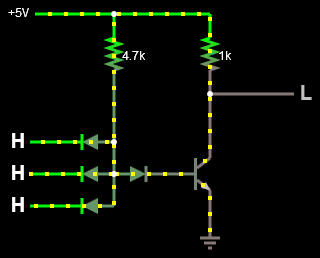(Mark can probably chime in about real Not implementations.) And will...
Check out
http://www.falstad.com/circuit/e-dtlnand.html
This is a simulation of a simple type of Nand gate, specifically a 3-input DTL Nand gate, on which you can change the inputs and see how it finctions.
It consists of 4 diodes, 2 resisters and a transistor. The three diodes on the left form the 3-input And part of the circuit and the diode and transistor on the right form the inverter. Eliminating one of the left-hand diodes turns this into a 2-input Nand. Eliminating 2 of the left-hand diodes turns it into a 1-input Nand--which has a more common name 8^).
Playing with this simulation should give you an idea for another solution for Not from Nand that doesn't involve tying the inputs together.
--Mark